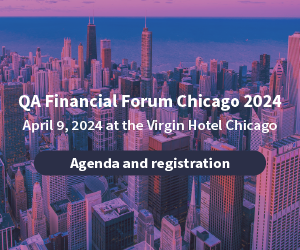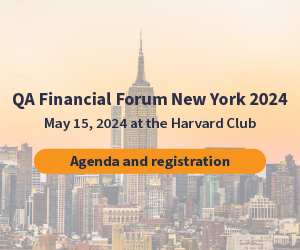Ai for Alpha is integrating generative artificial intelligence solution into its asset management models, the French AI startup shared with QA Financial last month.
The Paris-based firm, a provider of AI-powered market signals and investment models, works with dozens of asset managers, banks and other financials services firms across Europe, North America and large parts of Asia.
By utilizing advanced technologies like RAG, or Retrieval Augmented Generation, generative AI can analyse a variety of sources, offering an up-to-date perspective on investor sentiment and market trends.
Investment professionals find it valuable to combine the analysis of investor sentiments with market indicators such as trends, risk aversion, and other market factors, explained CEO Beatrice Guez.
QA Financial caught up with Guez to zoom in on her company’s AI-powered investment tools and to discuss how AI is increasingly being integrated into the ecosystems of banks and investment firms around the world.
Q: You recently announced your firm plans to integrate generative artificial intelligence solution into its asset management models. Tell us more.
Beatrice Guez: Ai for Alpha research is recognized by the scientific community, and we frequently publish in top AI conferences. Our team brings cutting-edge AI to the asset management sector, focusing on the latest developments in Natural Language Processing.
Our technology allows to analyze massive amounts of economic data in real-time, giving a clearer picture of the daily market sentiment. Specifically, our team utilizes Large Language Models (LLMs) for to analyze market sentiments and anticipate market movements based on news and investor sentiments. Our research demonstrates that LLMs are very effective in processing extensive financial datasets.

“Our main challenge when designing an AI strategy is to be able to explain the results from our models.”
– Beatrice Guez
Q: How can Gen AI-powered model bring substantial improvements in the risk management of clients’ equity portfolios?
Beatrice Guez: AI-driven models are a game changer for risk management. Our latest strategy, utilizing GPT technology, capitalizes on the most recent AI advancements to analyze vast quantities of textual data alongside various stress indicators, yielding strong results.
Our models excel in detecting sentiments that other signals-based technologies might miss thanks to the application of LLMs, which have substantially advanced our ability to predict crises, offering a more robust approach to anticipating market shifts and improve the risk adjusted return of an equity allocation.
Q: To dive a bit deeper into your platform, what are the challenges of building methodologies such as reinforcement learning into the applications and the investment platform you offer your customers?
Beatrice Guez: We are a model provider working with investment platforms. Our main challenge when designing an AI strategy is to be able to explain the results from our models. Investors would not feel comfortable to invest in a “black box” solution.
Our “explainable Ai 360” approach allows to identify the relationships between investment factors and financial strategies helping our clients to make informed investment decisions. Our clients have access to the key market drivers that led to the model decision on a daily basis. For example, on our solution based on Generative AI, our clients have access to the news and headlines driving the strategy allocation.
Q: And how do you test the functionality and performance of your applications, given that your algos are your competitive edge?
Beatrice Guez: All the strategies and models we developed have a benchmark. This allows to objectively quantify the value added of the model in real time. For example, our NLP (Natural Language Processing) indicator improves the sharpe ratio of the strategy from 0.7 to 0.9.
Q: The market is increasingly crowded, more and more competitive. How do you compete stand out? And compete with large tech companies with deep pockets?
Beatrice Guez: We have a unique DNA combining Ai experts with finance and asset management professionals allowing us to get a more robust approach. Banks and institutions who have been working with us for a few years now value that approach which differentiates us from the pure tech companies.
Q: So what is it that makes you different from the market leaders in robo-investment: Moneyfarm, Betterment, Nutmeg?
Beatrice Guez: We are totally different as we are using AI signals to implement investment strategies with a goal to outperform a benchmark. We work with institutional clients who are highly sophisticated. Robot-advisors are focused on automatic allocations to a portfolio of trackers based on retail investor’s risk profile.
“We want regulation. It is key to protect investors’ interests.”
– Beatrice Guez
Q: Looking at the wider market and your place in this ecosystem, what are some of the key challenges you and the wider industry currently face?
Beatrice Guez: Even if Open Ai and Chat GPT have demonstrated the tremendous potential of artificial intelligence, clients need to understand the rationale behind any model’s decisions. This is why our approach is based on “Explainable Ai” that is key to shed light on market drivers. Our clients value the transparency of our models and the measurable “value-added” of our strategies in comparison to well identified benchmarks.
Q: Finally, it is often said regulation can barely keep up with the rapidly evolving tech ecosystems we operate in. Do you agree? Has regulation become a burden?
Beatrice Guez: We want regulations. Regulation is key to protect investors’ interests. It is particularly important to avoid “black box investments” and risks of unexpected drawdowns.
Q: Given this increasing scrutiny of AI-based applications, how are you building anticipated compliance requirements into your apps?
Beatrice Guez: As a model provider, we only work with professional investors who are keeping full control on the execution of the strategy and ensure compliance requirements. To avoid unexpected drawdowns and risks, the team always ensures that all backtests are rigorously executed out-of-sample, with no risk of data leakage or over-fitting. Other safeguards include running the same model in different markets to ensure consistency and analyzing the sensitivity of meta-parameters. All these safeguards are necessary to develop robust solutions for end-investors.
ALSO READ




